
Tricholoma is a genus of fungus that contains many fairly fleshy white-spored gilled mushrooms which are found worldwide generally growing in woodlands. These are ectomycorrhizal fungi, existing in a symbiotic relationship with various species of coniferous or broad-leaved trees. The generic name derives from Ancient Greek: τριχο-, romanized: tricho-, lit. 'hair' and Ancient Greek: λῶμα, romanized: loma, lit. 'fringe, border' although only a few species have shaggy caps which fit this description.
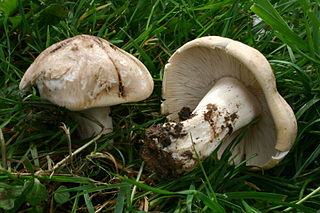
Calocybe gambosa, commonly known as St. George's mushroom, is an edible mushroom that grows mainly in fields, grass verges and roadsides. Deriving its common name from when it first appears in the UK, namely on St George's Day. It appears in March in Italy, a warmer country where it is also a popular mushroom to eat, and is known there as prugnolo. It is also popular in Northern Spain and Southern France, in the Basque Country region and its surroundings where it appears in April. In these regions it is usually eaten sautéed with egg or with bacon.

Entoloma sinuatum is a poisonous mushroom found across Europe and North America. Some guidebooks refer to it by its older scientific names of Entoloma lividum or Rhodophyllus sinuatus. The largest mushroom of the genus of pink-spored fungi known as Entoloma, it is also the type species. Appearing in late summer and autumn, fruit bodies are found in deciduous woodlands on clay or chalky soils, or nearby parklands, sometimes in the form of fairy rings. Solid in shape, they resemble members of the genus Tricholoma. The ivory to light grey-brown cap is up to 20 cm (7.9 in) across with a margin that is rolled inward. The sinuate gills are pale and often yellowish, becoming pink as the spores develop. The thick whitish stem has no ring.

Tricholoma equestre or Tricholoma flavovirens, commonly known as the man on horseback or yellow knight is a widely eaten but arguably toxic fungus of the genus Tricholoma that forms ectomycorrhiza with pine trees.
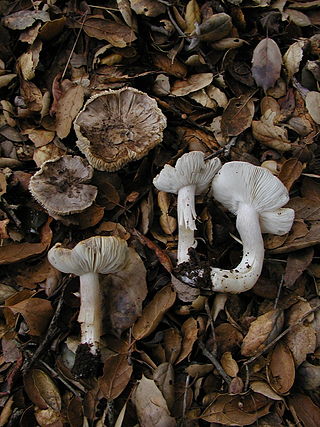
Tricholoma argyraceum is a grey-capped mushroom of the large genus Tricholoma. It has been often confused with the similar-looking Tricholoma scalpturatum.

Clitocybe dealbata, also known as the ivory funnel, is a small white funnel-shaped basidiomycete fungus widely found in lawns, meadows and other grassy areas in Europe and North America. Also known as the sweating mushroom, or sweat producing clitocybe, it derives these names from the symptoms of poisoning. It contains potentially deadly levels of muscarine.

Tricholoma pardinum, commonly known as spotted tricholoma, tiger tricholoma, tigertop, leopard knight, or dirty trich, is a gilled mushroom widely distributed across North America, Europe, and parts of Asia. It is generally found in beech woodland in summer and autumn. Two subspecies have been described from southern Europe. First officially described by Christiaan Hendrik Persoon in 1801, T. pardinum has had a confusing taxonomic history that extends over two centuries. In 1762, German naturalist Jacob Christian Schäffer described the species Agaricus tigrinus with an illustration corresponding to what is thought to be T. pardinum, and consequently, the name Tricholoma tigrinum has been used erroneously in some European field guides.
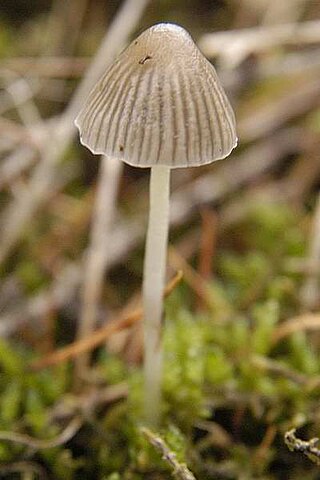
Mycena leptocephala, commonly known as the nitrous bonnet, is a species of fungus in the family Mycenaceae. The mushrooms have conical grayish caps that reach up to 3 cm (1.2 in) in diameter, and thin fragile stems up to 5 cm (2.0 in) long. The gills are gray and distantly spaced. The spores are elliptical, typically measure 7–10 by 4–6 μm, and are white in deposit. When viewed under a light microscope, the gills have abundant spindle-shaped cystidia on the gill edges, but few on the gill faces. The mushroom is found in North America, Asia, and Europe where it grows singly or in groups on conifer needles, cones and sticks on the forest floor. It has a distinctive odor of bleach; the edibility is unknown. Similar species include Mycena alcalina, M. austera, and M. brevipes.

Tricholoma columbetta, commonly known as dove-coloured tricholoma, is an edible mushroom of the large genus Tricholoma. It is found in Europe, where it is eaten in France.

Tricholoma portentosum, commonly known as the charbonnier, streaked tricholoma, or sooty head, in North America, is a grey-capped edible mushroom of the large genus Tricholoma. It is found in woodlands in Europe and North America.
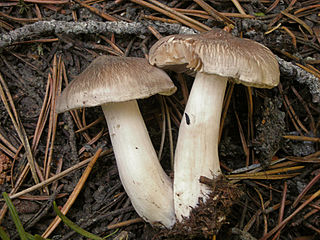
Tricholoma virgatum, commonly known as the ashen knight, is a mushroom of the agaric genus Tricholoma. It was first described scientifically as Agaricus virgatus by Elias Fries in 1818, and later transferred to the genus Tricholoma by Paul Kummer in 1871. It is found in the deciduous and coniferous forests of Europe, North America, and China. The mushroom is inedible, speculated to be poisonous, and has a bitter and peppery taste and musty odor.

Tricholoma ustale, commonly known as the burnt knight, is a species of mushroom in the large genus Tricholoma. It is found in Asia, Europe, and North America, though those from North America may represent one or more different species.

Tricholoma cingulatum is a mushroom of the agaric genus Tricholoma. First described in 1830 as Agaricus cingulatus by Elias Magnus Fries, it was transferred to the genus Tricholoma by Almfelt in 1830.

Tricholoma inamoenum is a mushroom of the agaric genus Tricholoma found through the Northern Hemisphere, particularly under conifers. It is poisonous, and is characterized by an unpleasant odor resembling coal gas or tar. • Analysis of the volatile compounds emanating from fresh sporocarps using solid phase microextraction (SPME) showed the odor compounds responsible for the coal tar odor of this mushroom are 1-octen-3-ol and indole.

Tricholoma pessundatum is a mushroom of the agaric genus Tricholoma. First described as Agaricus pessundatus by Elias Magnus Fries in 1821, it was transferred to the genus Tricholoma by Lucien Quélet in 1872.
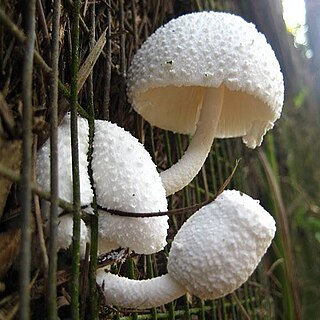
Leucocoprinus cretaceus is a species of mushroom producing fungus in the family Agaricaceae. It is likely tropical in origin although it was first documented in Europe where it was often found growing in greenhouses and bark beds. However many early observations conflate this species with Leucocoprinus birnbaumii or Leucocoprinus cepistipes despite sharing only some superficial similarities. This fungus is quite versatile even for a saprotroph and is often found growing in clusters on woodchips, sawdust and compost heaps as well as directly from the ground or on trees. It may also appear in plant pots and greenhouses in colder countries in which it is not well equipped to survive outside.

Hygrophorus russula, commonly known as the pinkmottle woodwax, false russula, or russula-like waxy cap, is a fungus native to North America and Europe.

Tricholoma acerbum is a mushroom of the agaric family Tricholomataceae. It is found in Europe and North America.


















